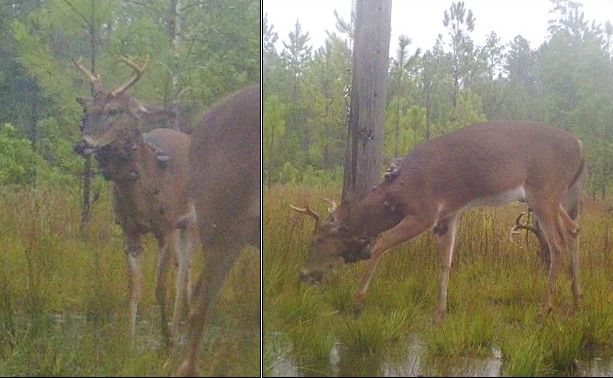What are deer warts?
Deer warts, also called cutaneous fibromas, are tiny tumors that manifest as wart-like growths on the skin of white-tailed deer and other cervids (deer). They are a result of papillomavirus infection from the Papillomaviridae family, and they are the most prevalent tumors seen in deer. Typically, these warts do not harm deer, but, in rare instances, they may become numerous and large enough to interfere with sight, movement, or feeding. In the great majority of cases, over time, the immune system aids in reducing and eventually eliminating the infection.
Other species like cows and dogs also circulate papilloma viruses that also cause lumps or "warts," but most viruses appear to be species specific. There are some exceptions, such as a cattle papilloma (Bovine papillomavirus) that can also infect horses, but the virus that causes warts in deer is specific to deer.
This publication provides essential insights into cutaneous fibroma, a common skin disease found in white-tailed deer. It is written for a diverse audience including deer farmers, wildlife biologists, veterinarians, managers, hunters, and outdoor enthusiasts. The aim of the publication is to explain the significance of this disease in white-tailed deer and its implications for the species.
Description
Wart-like growths found on white-tailed deer and other deer are called fibromas, or, more commonly, skin tumors or warts. These growths are categorized by histopathologists as papillomas, fibromas, or papillofibromas based on the predominant tissue type within the tumor. However, they are all associated with the same virus and mainly differ in their appearance due to the age of the growth. We will collectively refer to them as fibromas.
Fibromas are unique, solid nodular masses exclusively attached to the skin. They vary in size, ranging from 1/4 inch to over 4 inches, and typically have a fleshy texture. They can be gray or dark colored, and can become abraded and bleed. Alternatively, they may be black, dry, and hard with a cauliflower-like appearance, particularly in larger growths that often hang pendulously due to their weight and their stem-like attachment to the skin.
Fibromas can occur anywhere on the body but are most common around the eyes, neck, face, and forelegs. They can manifest as single growths or occur in groups. Light infections are prevalent in white-tailed deer, with some individuals hosting 25 or more growths. In severe cases of multiple infections, these growths may merge into a coalesced mass, although such extensive involvement is quite rare.

Credit: Mr. Scott Miller
Distribution and Transmission
White-tailed deer fibroma is widespread and occurs across the entire North American range of the species. In laboratory settings, fibromas can be mechanically transmitted by applying fibroma tissue to a susceptible deer's scratched skin; however, the natural transmission process remains unclear. It is possible that transmission occurs via contact between broken skin and infectious material, either from an infected deer or from vegetation that an infected deer has touched or brushed against. The notably higher occurrence of fibromas among bucks suggests that fighting may play a role in disease transmission. Additionally, it is suspected that biting insects may act as vectors for the virus.
Diagnosis
Diagnosing this condition involves looking at how these growths appear and at their structure. One important clue is that they're only connected to the skin, not the muscles and bones underneath. For a clear diagnosis, a veterinarian should examine tissue from the growths under a microscope in a process called histopathological examination. This diagnostic tool helps confirm the diagnosis.
Treatment and Control
Wild deer populations are typically not treated because the disease does not pose a significant health issue. In captive herds, surgical removal of the growths is an option if the growths become problematic to the individual deer. There is no vaccine for this disease. Given that exposure to the virus results in immunity, it may be possible to develop a vaccine should preventive measures become necessary. At present, however, clinical disease occurrences have been too infrequent to warrant these interventions.
Importance
The lumps caused by fibromatosis sometimes create an aesthetic concern for farmers and hunters and can render deer carcasses unsuitable for trophies, but this disease is otherwise mostly harmless. Fibromatosis does not typically cause serious health problems for deer or kill them, and most deer clear the infection over time; the disease is not transmissible to humans or other species; and the fibromas do not affect the quality of deer meat. To summarize, although deer warts are unsightly, they typically do not cause deer mortality, do not affect the quality of deer meat, and do not spread to species other than deer or pose danger to people, pets, livestock, or other wildlife.
References
Groff, D. E, and W. D. Lancaster. 1985. “Molecular Cloning and Nucleotide Sequence of Deer Papillomavirus.” Journal of Virology 56 (1): 85–91. https://doi.org/10.1128/jvi.56.1.85-91.1985
Lancaster, W. D., and J. P. Sundberg. 1982. “Characterization of Papillomaviruses Isolated from Cutaneous Fibromas of White-Tailed Deer and Mule Deer.” Virology 123 (1): 212–216. https://doi.org/10.1016/0042-6822(82)90307-5
Lubna, K., and M. S. Campo. 2008. “Bovine Papillomaviruses: Their Role in The Aetiology of Cutaneous Tumours of Bovids and Equids.” Veterinary Dermatology 19 (5): 243–254. https://doi.org/10.1111/j.1365-3164.2008.00683.x
Michigan Department of Natural Resources. n.d. “Deer Fibroma” https://www.michigan.gov/dnr/managing-resources/wildlife/wildlife-disease/wdm/deer-fibroma
Nemeth, N., and M. Yabsley. 2021. Field Manual of Wildlife Diseases in the Southeastern United States. 4th. ed. Athens, Ga: Southeastern Cooperative Wildlife Disease Study, College of Veterinary Medicine, The University of Georgia. Print. https://vet.uga.edu/education/academic-departments/population-health/southeastern-cooperative-wildlife-disease-study/scwds-resources-2/scwds-field-manual/
Obanion, M. K., and J. P. Sundberg. 1987. “Papillomavirus Genomes in Experimentally Induced Fibromas in White-Tailed Deer.” American Journal of Veterinary Research 48 (10): 1453–1455.
Scagliarini, A., L. Gallina, M. Battilani, F. Turrini, F. Savini, A. Lavazza, M. Chiari, et al. 2013. “Cervus elaphus Papillomavirus (CePV1): New Insights on Viral Evolution in Deer.” Veterinary Microbiology 165 (3–4): 252–259. https://doi.org/10.1016/j.vetmic.2013.03.012